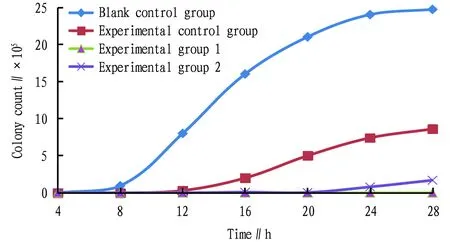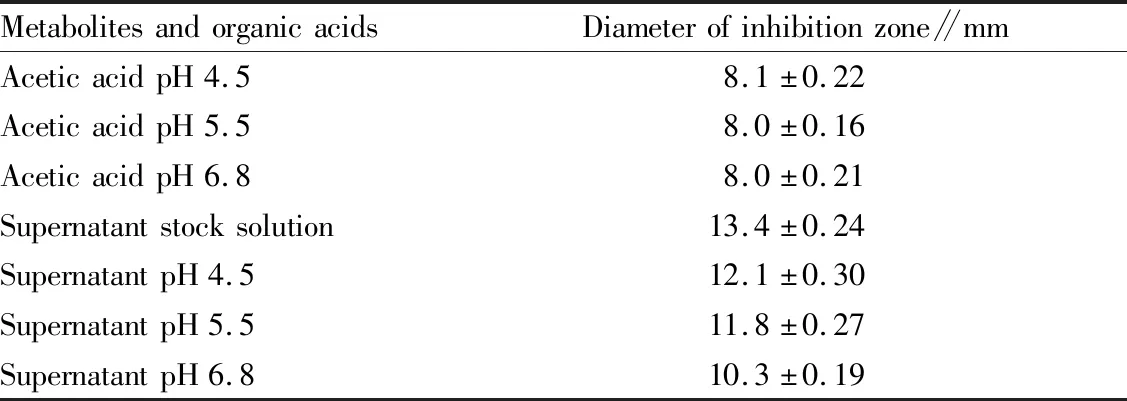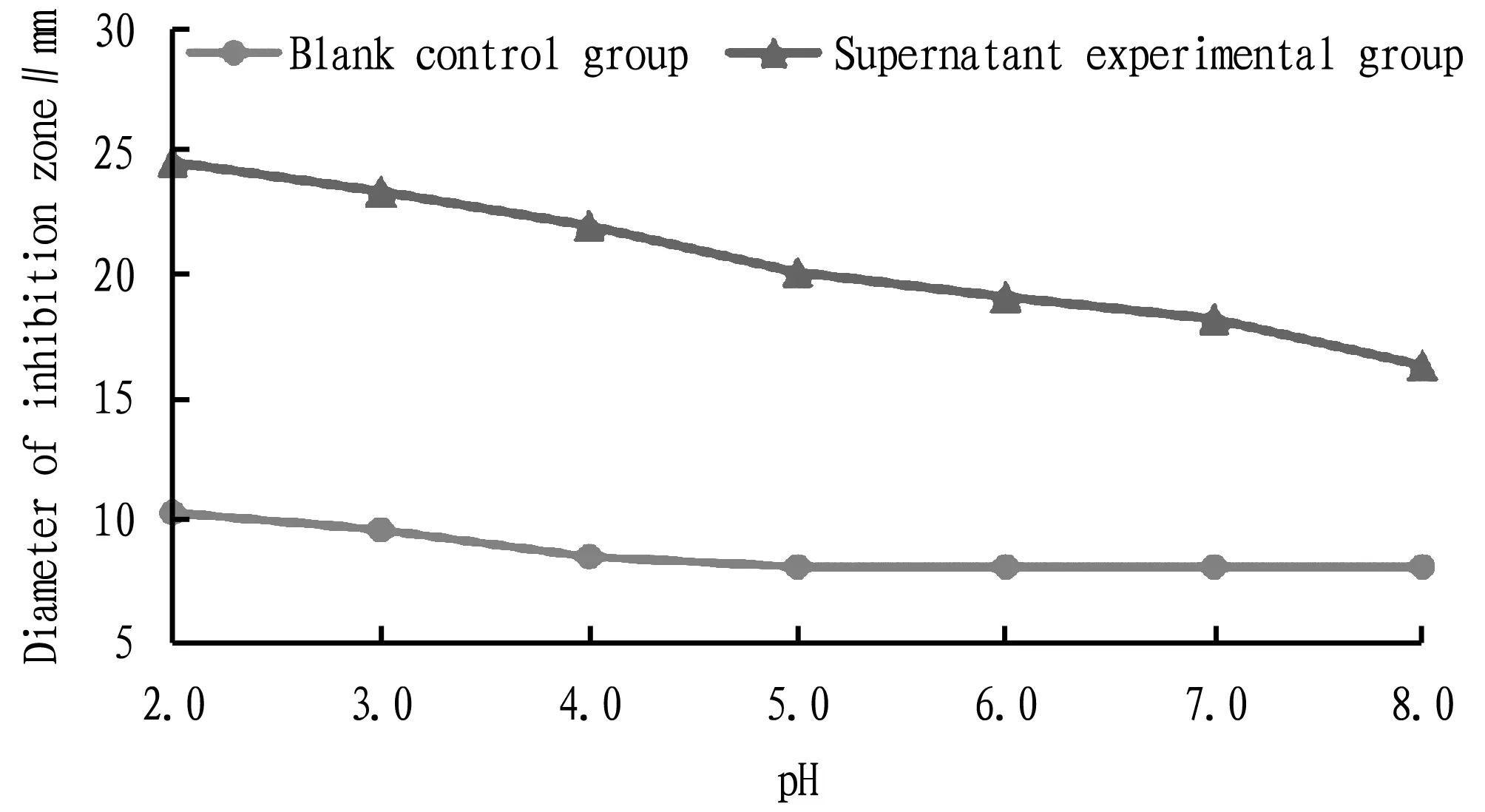Inhibitory Effect of Lactic Acid Bacteria on Salmonella
Yunxia WANG, Lijuan JING, Shuhuan ZHAO, Lijun LIU, Cuizhi LI*, Zhiyong LU, Zhijun LI
1. Quality Management Department, Inner Mongolia Yili Industrial Group Co., Ltd., Hohhot 010110, China; 2. Quality Management Department of Yogurt Division, Inner Mongolia Yili Industrial Group Co., Ltd., Hohhot 010110, China
Abstract [Objectives] To explore the inhibitory effect of lactic acid bacteria (LAB) on the growth of Salmonella. [Methods] The inhibitory effect of lactic acid bacteria on Salmonella was investigated by Oxford cup agar diffusion test from the aspects of lactic acid bacteria body, metabolites, pH, thermal stability and acid resistance. [Results] The growth of Salmonella was disturbed by the inhibition of lactic acid bacteria. The mechanism of inhibitory effect may be: simple low pH and lactic acid bacteria have no inhibitory effect on Salmonella; however, there are active substances in the metabolites of lactic acid bacteria, which have high thermal stability and a wide range of acid resistance, and are effective substances for inhibiting the growth of Salmonella. [Conclusions] This study is helpful for screening more natural preservative substances, reducing the contamination rate of Salmonella to food, and is expected to provide a theoretical basis for the preservation and preservation of food.
Key words Lactic acid bacteria (LAB), Fermented product, Salmonella, Inhibitory effect
1 Introduction
Lactic acid bacteria (LAB) are a group of Gram-positive bacteria that mainly produce large amounts of lactic acid by fermenting sugar. They are widely distributed in nature, including the commonLactobacillus,Lactococcus,Bifidobacterium, StreptococcusStreptococcusthermophilus,etc.China has a long history in the application of lactic acid bacteria in food fermentation and processing. As early as in the Tang Dynasty, there were records of making "yogurt", and then there were various applications such as making wine, pickling vegetables, fermenting dairy products, and processing fruit juices[1-2]. At present, it is generally believed that lactic acid bacteria can produce many kinds of substances, such as lactic acid, acetic acid, and bacteriocin during the fermentation process. These substances, to a certain extent, not only improve the flavor and tissue state of the food[3], but also inhibit the growth of bacteria and play a magical preservative role.
In 1998, Corsettietal.[4]found that the organic acid produced by the fermentation of lactic acid bacteria has an inhibitory effect on mold. Zhang Xietal.[5]found that the products of lactic acid bacteria showed obvious bacteriostatic effect onEscherichiacoilO157. Some scholars thought that the organic acid produced by fermentation significantly reduces the pH of the growth environment and interferes with the growth of bacteria. Some researchers believed that they are produced from the synergistic effect caused by the metabolites of lactic acid bacteria fermentation. In 2009, Gulahmadovetal.[6]demonstrated that a variety of natural bacteriostatic substances such as bacteriocin and hydrogen peroxide are produced during the metabolism of lactic acid bacteria. These active substances attack the cell membrane[7-9], inhibit the synthesis of proteins or inhibit the cellular respiratory chain, so that the cell ruptures and die, so as to inhibit the bacteria.
In this study, we explored the inhibitory effect of lactic acid bacteria on Salmonella from the aspects of lactic acid bacteria body, metabolites, pH, thermal stability and acid resistance. This study is helpful for screening more natural preservative substances, reducing the contamination rate of Salmonella to food, and is expected to provide a theoretical basis for the preservation and preservation of food.
2 Materials and methods
2.1 Materials
2.1.1Strains. Lactic acid bacteria were isolated from fermented milk samples;Salmonellatyphistrain (ATCC14028) was purchased from the American Type Culture Collection.
2.1.2Culture media and reagents. BPW medium, MRS medium, MRS broth, NA medium, and physiological saline were purchased from Beijing Land Bridge Technology Co., Ltd.; sodium hydroxide (NaOH) and hydrochloric acid were purchased from Tianjin Beifang Tianyi Chemical Reagents Factory.
2.1.3Instrument and equipment. The analytical balance and pH meter were purchased from Mettler Toledo Group (Switzerland); the biological safety cabinet (BSC) was purchased from Thermo Fisher Scientific Inc. (USA); the constant temperature incubator was purchased from Shanghai Yuejin Medical Devices Co., Ltd. (China); the vernier caliper was purchased from Andis Measurement and Control Technology Co., Ltd. (China); the autoclave was purchased from Zealway (Xiamen) Instrument Inc. (China).
2.2 Methods
2.2.1Isolation of lactic acid bacteria. The lactic acid bacteria in the fermented milk products were isolated and cultured, and the single colony of lactic acid bacteria was picked and purified on the MRS solid culture medium, and at the same time inoculated MRS broth culture medium, and cultured under anaerobic condition at 36 ℃ for 72 h, finally single colonies were picked for Gram staining observation.
2.2.2Extraction of supernatant from lactic acid bacteria metabolism. Take 500 μL of the above-mentioned MRS liquid culture medium and inoculated in a newly prepared 10 mL MRS broth culture medium, oscillated well and cultured under anaerobic condition at 36 ℃ for 72 h, centrifuged at 10 000 r/min for 10 min at 4 ℃, and extracted the supernatant for later use.
2.2.3Culture of Salmonella. Pipetted 500 μL of the frozen bacterial solution ofSalmonellatyphiand inoculated into BHI broth culture medium, incubated at a constant temperature of 37 ℃ for 24 h, picked the cultured bacterial solution, streaked and purified on NA medium, and cultured at a constant temperature of 37 ℃ for 24 h to obtain single colonies for later use.
2.2.4Bacteriostatic mechanism. (i) Effect of lactic acid bacteria on the growth of Salmonella. According to the nutritional requirements and conditions of Salmonella culture, BPW medium was selected and Salmonella was cultured at a constant temperature of 36 ℃. Taking BPW+Salmonellatyphi(the amount of added bacteria was 5 CFU/25 g) as blank control group, BPW+boiled lactic acid bacteria+Salmonellatyphi(the amount of bacteria added was 5 CFU/25 g) as the experimental control group, BPW+lactic acid bacteria+Salmonellatyphi(the amount of bacteria added was 5 CFU/25 g) as experimental group 1, and BPW+lactic acid bacteria+Salmonellatyphi(the amount of bacteria added was 50 CFU/25 g) as experimental group 2, we measured the number of colonies of Salmonella in each group in 0, 4, 8, 12, 16, 20, 24 and 28 h growth periods, and plotted bacterial growth curve (Fig.1).

Fig.1 Growth curve of Salmonella affected by lactic acid bacteria
(ii) Effect of lactic acid bacteria metabolites on inhibiting Salmonella. We tested the bacteriostatic effect by Oxford cup agar diffusion method. AddedSalmonellatyphi(the concentration of the bacterial solution was 106CFU/mL) to NA agar at 1∶20, and slowly poured into a petri dish that has been placed in an Oxford cup (inner diameter 6 mm, outer diameter 8 mm). After the agar was solidified, carefully took out the Oxford cup to make a plate containing bacteria with wells. Took the lactic acid bacteria metabolic supernatant and the lactic acid bacteria metabolic supernatant with pH adjusted to 4.5, 5.5 and 6.8 respectively; taking acetic acid with the same pH of 4.5, 5.5 and 6.8 as the control group, pipetted 200 μL into different wells, and measured the diameter of the inhibition zone with a vernier caliper after culturing at 37 ℃ for 24 h (Fig.2).

Fig.2 Bacteriostatic effect of lactic acid bacteria metabolites on Salmonella
2.2.5Properties of bacteriostatic active substances. (i) Thermal stability. Took 5 pieces of lactic acid bacteria metabolic supernatant and heated them at 37, 60, 80, 100 and 121 ℃ for 30 min, respectively. After cooling in an ice bath, poured the supernatant of each group into the plate wells containing Salmonella at 37 ℃ and cultured for 24 h for bacteriostatic experiments. Taking the unheated metabolic supernatant as the blank control, we measured the diameter of the inhibition zone under different temperature conditions, and analyzed the thermal stability of the bacteriostatic active substances.
(ii) Acid resistance. Took 7 pieces of lactic acid bacteria metabolic supernatant, adjusted the pH to 2.0, 3.0, 4.0, 5.0, 6.0, 7.0, 8.0 with 2 mol/L HCl and 2 mol/L NaOH solution, respectively. Poured the supernatant of each group into the plate wells containing Salmonella at 37 ℃ and cultured for 24 h for bacteriostatic experiments. Taking the acetic acid of the same pH as the blank control, we measured the diameter of the inhibition zone under different pH and analyzed the acid resistance and stability of the bacteriostatic active substances.
3 Results and analysis
3.1 Isolation of lactic acid bacteriaThe colonies of lactic acid bacteria on the MRS plate were white, round and smooth, with neat edges and a slight bulge in the middle. In MRS broth, the colonies were turbid, with bacterial cell precipitation, and were observed as Gram-positive bacilli after Gram staining.
3.2 Effect of lactic acid bacteria on the growth of SalmonellaThrough measuring the changes in the number of colonies ofSalmonellatyphiduring the 0-24 h bacterial enrichment process and plotting the bacterial growth curve, we found that the experimental blank group was not affected by lactic acid bacteria, Salmonella grew normally, and the growth showed an S-shaped curve. In the experimental control group, the lactic acid bacteria died or were seriously damaged during the boiling process, but they still had a certain inhibitory effect on Salmonella, but the effect was not as strong as the experimental group. In the experimental group 2, the proliferation and growth of Salmonella was extremely weak, the growth curve had a longer retardation period, and the peak value of the logarithmic phase was significantly lower than that of the blank control group and the experimental control group. In the experimental group 1, because the initial number of Salmonella was less than that of experimental group 2, it was more affected by the bacteriostatic substances of lactic acid bacteria, and there was almost no proliferative growth phenomenon. These indicate that lactic acid bacteria have obvious inhibitory effect on the proliferation and growth ofSalmonellatyphi, and the strength of the inhibitory effect is related to the concentration of bacterial metabolites.
3.3 Bacteriostatic effect of lactic acid bacteria metabolites on SalmonellaTaking the lactic acid bacteria metabolic supernatant, the supernatant whose pH was adjusted to 4.5, 5.5 and 6.8, and the acetic acid whose pH was 4.5, 5.5 and 6.8, we carried out the bacteriostatic test and found that: acetic acid with low pH had almost no inhibitory effect on Salmonella, but lactic acid bacteria culture supernatant showed strong inhibitory effect on Salmonella. In addition, the lactic acid bacteria metabolic supernatants with pH of 4.5, 5.5 and 6.8 has certain inhibitory effect on Salmonella, but the effect was more significant than that of the lactic acid bacteria metabolic supernatants (Table 1). These indicate that the low pH environment is indeed more suitable for the growth of lactic acid bacteria and is not conducive to the growth of Salmonella. However, the simple low pH is not the main factor, but only has an intolerable environmental impact on the growth of the bacteria. Apart from the low pH acidic environment, there are more intense bacteriostatic active substances in the lactic acid bacteria metabolic supernatant.

Table 1 Comparison of bacteriostatic effect of lactic acid bacteria metabolites and organic acids
3.4 Properties of bacteriostatic active substances(i) Thermal stability. After the lactic acid bacteria metabolic supernatant was heated at different temperatures for 30 min, the bacteriostatic activity gradually weakened with the rise of temperature; the bacteriostatic active substances still had good antibacterial effect in the range of 80 ℃; after being treated at 100 ℃, their bacteriostatic activity was almost lost, and the bacteriostatic effect was minimal (Fig.3). These indicate that high temperature treatment will destroy the activity of the bacteriostatic substances produced by the metabolism of lactic acid bacteria. However, the thermal stability of lactic acid bacteria is better in the temperature range below 80 ℃, and the bacteriostatic effect is relatively stable.

Fig.3 Thermal stability of bacteriostatic active substances
(ii) Acid resistance. After the lactic acid bacteria metabolic supernatant was treated with different pH, the bacteriostatic activity gradually weakened with the increase of pH. Bacteriostatic active substances are sensitive to low pH. As shown in Fig.4, in the range of pH 2.0-4.0, both the control group and the experimental group showed a certain bacteriostatic activity against Salmonella mainly because the bacteriostatic effect was strong under low acid condition, and the effect was obvious. After the pH was adjusted to 5.0, the bacteriostatic active substances in the control group had no inhibitory effect on Salmonella, while the metabolic supernatant still had antibacterial activity under this pH condition, and the bacteriostatic active substances played the main bacteriostatic effect. In the range of pH 6.0-7.0, bacteriostatic active substances still had certain bacteriostatic effect; in the range of pH 5.0-7.0, the diameter of the inhibition zone gradually decreased with the increase of pH; after the pH exceeded 8.0, bacteriostatic active substances lost their bacteriostatic effect on Salmonella. These indicate that the pH of the bacteriostatic active substance is wider, the acid resistance is stronger, and the inhibitory effect of the bacteriostatic active substances under the synergistic effect of the low acid environment is stronger, and the effect is more obvious.

Fig.4 Acid resistance of bacteriostatic active substances
4 Discussion
The bacteriostatic activity of lactic acid bacteria metabolites comes from many aspects, mainly organic acids, lactobacillus and other substances[10-22]. The bacteriostatic experimental results of the lactic acid bacteria metabolites after treatment showed that the lactic acid bacteria metabolites have good thermal stability; the pH exerts a significant effect on the bacteriostatic ability of lactic acid bacteria metabolites; the lower the pH, the stronger the bacteriostatic ability of lactic acid bacteria metabolites. In addition, the latest findings of Setyawardani’s team[23]shows that the lactic acid bacteria would synthesize and secrete a class of bacteriostatic proteins or polypeptides during the metabolic process, which have good thermal stability and low sensitivity to proteases, and both have bacteriostatic effect and are more active under acidic conditions, which are consistent with the results of this experiment. However, the bacteriostatic substances produced by the metabolism of lactic acid bacteria are complex, and the bacteriostatic effect may also involve the synergistic effect of various mechanisms[24]. The study of bacteriostatic active substances can also be separated into a single active ingredient, and then combined with the characteristics of the substance[25-26]and safety to further explore. Therefore, the bacteriostatic active substances produced by the metabolism of lactic acid bacteria will have broader application prospects in food fermentation and production.
 Asian Agricultural Research2022年5期
Asian Agricultural Research2022年5期
- Asian Agricultural Research的其它文章
- Status Investigation and Countermeasures of Green Development of Black Talc Industry Chain in Guangfeng District, Jiangxi Province
- Cloning and Bioinformatics Analysis of TpiA Gene of Vibrio alginolyticus HY9901
- Antagonistic Effects of Sphingomonas and Pseudomonas aeruginosa on 4 Kinds of Pathogenic Bacteria of Ginseng
- Bioinformatics Analysis of Xylanase xynMF13-GH10 Gene from Mangrove Fungi
- Methodological Research in the Field of Civil Aviation Safety
- Safety Evaluation of Water Environment Carrying Capacity of Five Cities in Ningxia Based on Ecological Footprint of Water Resources
